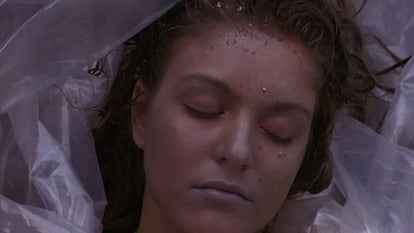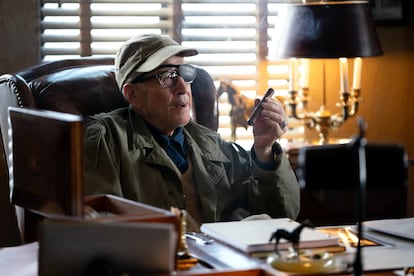David Lynch died Thursday against the backdrop of Los Angeles in flames. Fate—or whatever—wanted the life of one of the filmmakers who best understood the cursed and infernal underground of that magical city to go out while its hills burned. Maybe it made sense: although he was born in Montana, his lineage was in Los Angeles and in the fatality of its great creation, Hollywood, and is vital in a work closely linked to two central figures in the myth of that place, Marilyn Monroe, the great enigma of blonde and problematic goddesses, and John Ford, the majestic landscaper of an unfathomable land whose drift towards hell Lynch predicted like no one else.
The obsession with Marilyn crosses cinematography lynchiana but it is especially explicit in two works connected to each other: the series that marked the nineties, Twin Peaksand the movie Mulholland Drive (2001), today considered one of his masterpieces and which was originally intended as a spin off of the revolutionary television program. The first collaboration between Lynch and the co-author of Twin Peaks, Mark Frost, was an adaptation of Goddess (The secret lives of Marilyn Monroe)Anthony Summers’ biography of Marilyn focusing on the star’s final days. The film did not go ahead, but the obsession with the actress never subsided. Lynch, whose musical side would be worth another article, even dedicated a song to him. Nobody like her embodied the double face of Hollywood, and the filmmaker found in his macabre destiny the soul of his muses: brunettes dyed blonde, angels harassed by a chilling evil, victims of a power that destroys all goodness.
Lynch confessed that the Laura Palmer murdered in Twin Peaks was inspired by Marilyn, and that Mulholland Drive He spoke, even more directly, about her. Broken beauties attracted him as much as conspiracy theories about their end. “It is very difficult to express what Marilyn Monroe is hiding,” the filmmaker once said when trying to delve into his attraction for a woman whose mystery has crossed the United States since the middle of the 20th century.
In Lynch’s head, the fantasy of Hollywood was based on the disturbing and hallucinogenic imagination of The Wizard of Oz (the lost girls with red shoes) and also about the tragic fate of that unfortunate woman. In her films, the disturbing shadow of Norma Jean before she was Marilyn resurfaces. Like in that famous photograph that haunted the actress for life and in which her hair, still undyed, and her naked innocence appeared wrapped in a demonic red curtain. In that image, Lynch knew how to see the angel trapped in the evil of his destiny and, in an astonishing twist, he made an entire generation go from who killed Norma Jean? to who killed Laura Palmer?
The pictorial vocation of the filmmaker, who studied Fine Arts before film, is linked to American abstract expressionism. And like many great artists of his country, Lynch also pursued the secret of an immeasurable landscape. His knowledge and expression of that landscape (from the green forests of Washington State to the plains of the Midwest or the arid desert of California) connects him with John Ford. Also his work over time with a troupe of complicit interpreters. That’s why it wasn’t a simple whim that Steven Spielberg asked him to participate in The Fabelmans to make a cameo in the shoes of the director of Desert centaurs.

It is curious how Lynch, long before that beautiful film, had already adopted certain gestures that related him to the moody and sarcastic King of Monument Valley. Lynch, more affable, did not obsessively bite a white handkerchief, but his addiction to tobacco, his reticence with a closed accent and his sagging beige pants could refer to the image of the old Ford. The cliché that says that the director of The man who killed Liberty Valance He did not consider himself an artist and was buried long ago by anyone who knows his life and work (another thing is that he never flirtatiously admitted it). Like him, Lynch was a filmmaker of the myths of his country but seen from a new and hidden place. A cruel and violent underground that transformed popular culture from the avant-garde. If the classical paintings of Edward Hopper and Frederic Remington inspired Ford, Lynch found his answer in the poetic deformity of Francis Bacon’s portraits, and, above all, in the masculine fury of the action painting de Jackson Pollock.
In Twin Peaks: The Return —perhaps his great testament, made 25 years after the original series and after an arduous negotiation that guaranteed him freedom when creating—, Lynch filled images that do not refer only to the famous series with self-referential keys. In chapter eight it is impossible not to detect the trace of the artist and experimental filmmaker Bruce Conner through the apocalyptic imaginary of the atomic bomb and its giant mushroom. An image that also refers to eraser head (1977), with which Lynch burst onto the scene as a highly original voice. Legends, painting, music, video art, cinema, fair shows and burlesque, rock and roll… Through the layers of his lush imagination, Lynch pursued the specters behind the secret of Laura Palmer’s death to the end.
In his efforts, the filmmaker broke the boundaries of the landscape of classic cinema to tell us about a terrifying new nightmare about evil. Perhaps in the eighties and nineties its universe could be too cryptic and surreal, but it didn’t matter if you didn’t understand it because it dragged you down. Only his literally most Fordian film, A true story (1999), achieved unanimous applause. Today her work as a visionary can be interpreted by how she ventured into what her country was hiding. And that includes the flames that still ravage the city that best and most inspired him and the chills at the return of the worst ghosts of the United States, which appear on Donald Trump’s horizon.

